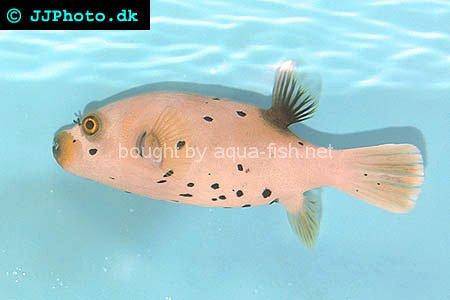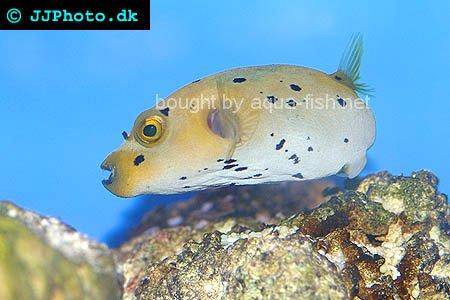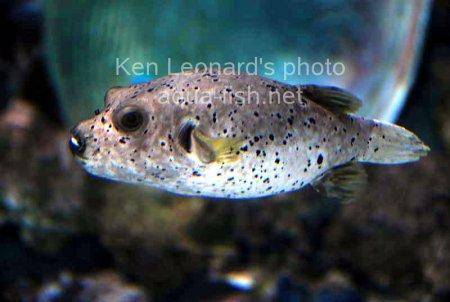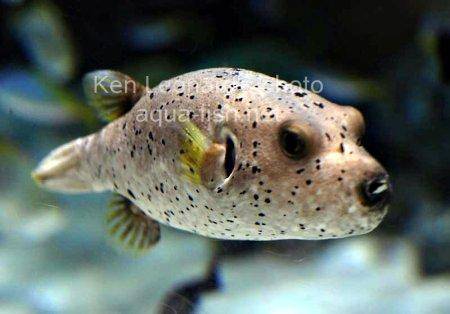Dogface Puffer
This marine aquarium fish is known as Dogface Puffer, Arothron Dogface Puffer, Blackspotted Puffer and the correct latin name is Arothron nigropunctatus. It belongs to the Puffer family. (e) It's origin is Indo-Pacific. (e)
Dogface Puffer can grow up to 33 cm what is approximately 12 inches. So 1 specimen requires at least 3960cm2 of water surface which is approximately 613 square inch. We recommend you to keep it in fish tanks which are large. (e) Medium aquariums have at least 113 Litres (30 US Gallons). Large aquariums have at least 265 Litres (70 US Gallons). Capacity of very large aquariums is at least 700 Litres (185 US Gallons).
It is not very difficult to keep the Dogface Puffer fish. (e) The specific gravity (SG) should be between 1,020 and 1,025, the temperature between 23°C (73.4°F) and 26°C (78.8°F). The suggested level of pH (a measure of the acidity/basicity) is between 8.0 and 8.3 which is usual for most marine fish.
The dog face puffer fish has proven to be a very popular species over the years for marine aquarium keepers and just looking at this fish often gives the reason why, they have the cutest of faces with the puppy dog eyes that seem too large for their head but you must remember that as they are puffer fish they will have their own personalities and can sometimes be extremely aggressive towards their tank mates especially if they are housed in incorrect conditions. The following article will supply you with the basic guidelines for caring for these fish.
So as already stated the dog face puffer fish is a saltwater species that originates from the Indo-pacific where they can be found from waters around Japan right down to the African continent, their Latin name is Arothron nigropuntatus and they do have a few common names including the Black spotted puffer and Arothron puffer, this can sometimes be misleading if different aquatic stores use the different common names, especially when the specimens are juveniles so it is always best to note down the Latin name and get the store keepers to verify that you are indeed purchasing the correct species.
Adult specimens can reach a length of up to 13 inches so bear this in mind when setting up a home for them, they will require at least a 100 gallon aquarium when fully grown, as jueniles you may get away with a smaller aquarium but you must be prepared to upgrade as the size of the puffer increases. Unless you have a very large aquarium it is not advised to keep more than one specimen together, they are extremely territorial and will fight with their own kind if the territory is encroached. They should also be kept with other species of fish that can look after themselves but not aggressive such as some of the more peaceful Tangs, Trigger fish, they can even be kept with different species of pufferfish but make sure that they settle in initally without any bullying taking place.
Of course there are certain guidelines that you should follow when setting up the aquarium, the dog face puffer is considered to be reef safe so they shouldn’t nibble at any corals but they can also be housed in a fish only set up with rocks etc. to break up lines of sight, using this method will decrease some of the territorial behaviour.
Salinity is a key factor, they do prefer a salinity of 1.020 to 1.025 but if they are housed in a reef set up you can slightly increase the salinity to 1.026 which is more suitable for the corals as well. Temperature wise they are fine with a temperature that ranges between 24 -27°C (74-80°F) and the pH should be maintained at a level of at least 8.1, if it is slightly higher then this is not a problem.
As mentioned with the fish only set up the d?cor in a reef set up should involve placing the live rock so that lines of sight are broken but always allow swimming space at the front of the aquarium and at the top of the reef, these fish can be very active.
I would recommend that some experience is obtained with easier species of fish before keeping the dog face puffer, they can be sensitive to poor water conditions and as explained in the next section they may be finnicky with their food.
When you first acclimatise the dog face pufferfish into your aquarium, like many marine species, getting this fish to feed can be frustrating initially as they may refuse food to start with but eventually with patience they will come round and accept food readily. They do require meaty foods but just offering these without any crustaceans can lead to problems with their beak becoming obvergrown , the shells of the crustaceans help to keep the beak ground back as it is constantly growing. Many sites recommend offering small fish such as silversides and small prawns etc, but you should also include in the diet foods such as snails, small clams. What you must remember is that when adding live foods to the aquarium you will increase the risk of adding bacteria or infections into the aquarium so always clean the food properly and there should be no problems. Flake food or small marine pellets can also be offered but keeping the diet varied will keep your fish interested in it’s food. If you are very experienced and the beak does start to extend over the lips you will probably trim it down yourself but unless you feel confident doing this I would recommend getting an experienced vetinary surgeon to perform this for you.
Unfortunately there are no reliable reported cases of the dog face pufferfish breeding in captivity, to try to attempt this would never work as the aggression shown between a pair enclosed in an aquarium would result in constant aggression. Sexing the dog face pufferfish is almost impossible unless you are an expert, as expected males will grow larger than the females but this is not a guaranteed way to sex these fish.
Keeping these fish is not that difficult if care is taken in the aquarium set up and the general guidelines are followed, they are not the hardest marine species to keep longterm but they are also not the easiest so try your hand at keeping some of the other marine species before keeping these fish.
Pufferfish do have the ability to inflate themselves, this ploy is often used to ward away predators by making them look bigger than they actually are, it has been known for some keepers to try to get their pufferfish to do this for their own amusement, this is not advised as it will usually result in the pufferfish becoming stressed and eventually will decrease their overall health.
We hope this article was informative and provided enough information to let you enjoy caring for these wonderful fish.


Thanks to Kenneth Leonard for the pictures. Copyright Ken Leonard.


Related fish profiles in the database
Feel free to share your experiences regarding keeping Arothron nigropunctatus below. Every message will be held for approval by our moderators. It usually takes 24 hours to publish your comment. Before you ask anything, browse the questions page, please.
Character and suggestions regarding care
Might be aggressive towards tankmates. Best kept alone or in very large aquariums.Dogface Puffer can grow up to 33 cm what is approximately 12 inches. So 1 specimen requires at least 3960cm2 of water surface which is approximately 613 square inch. We recommend you to keep it in fish tanks which are large. (e) Medium aquariums have at least 113 Litres (30 US Gallons). Large aquariums have at least 265 Litres (70 US Gallons). Capacity of very large aquariums is at least 700 Litres (185 US Gallons).
It is not very difficult to keep the Dogface Puffer fish. (e) The specific gravity (SG) should be between 1,020 and 1,025, the temperature between 23°C (73.4°F) and 26°C (78.8°F). The suggested level of pH (a measure of the acidity/basicity) is between 8.0 and 8.3 which is usual for most marine fish.
The dog face puffer fish has proven to be a very popular species over the years for marine aquarium keepers and just looking at this fish often gives the reason why, they have the cutest of faces with the puppy dog eyes that seem too large for their head but you must remember that as they are puffer fish they will have their own personalities and can sometimes be extremely aggressive towards their tank mates especially if they are housed in incorrect conditions. The following article will supply you with the basic guidelines for caring for these fish.
So as already stated the dog face puffer fish is a saltwater species that originates from the Indo-pacific where they can be found from waters around Japan right down to the African continent, their Latin name is Arothron nigropuntatus and they do have a few common names including the Black spotted puffer and Arothron puffer, this can sometimes be misleading if different aquatic stores use the different common names, especially when the specimens are juveniles so it is always best to note down the Latin name and get the store keepers to verify that you are indeed purchasing the correct species.
Aquarium set up and care
Adult specimens can reach a length of up to 13 inches so bear this in mind when setting up a home for them, they will require at least a 100 gallon aquarium when fully grown, as jueniles you may get away with a smaller aquarium but you must be prepared to upgrade as the size of the puffer increases. Unless you have a very large aquarium it is not advised to keep more than one specimen together, they are extremely territorial and will fight with their own kind if the territory is encroached. They should also be kept with other species of fish that can look after themselves but not aggressive such as some of the more peaceful Tangs, Trigger fish, they can even be kept with different species of pufferfish but make sure that they settle in initally without any bullying taking place.
Of course there are certain guidelines that you should follow when setting up the aquarium, the dog face puffer is considered to be reef safe so they shouldn’t nibble at any corals but they can also be housed in a fish only set up with rocks etc. to break up lines of sight, using this method will decrease some of the territorial behaviour.
Salinity is a key factor, they do prefer a salinity of 1.020 to 1.025 but if they are housed in a reef set up you can slightly increase the salinity to 1.026 which is more suitable for the corals as well. Temperature wise they are fine with a temperature that ranges between 24 -27°C (74-80°F) and the pH should be maintained at a level of at least 8.1, if it is slightly higher then this is not a problem.
As mentioned with the fish only set up the d?cor in a reef set up should involve placing the live rock so that lines of sight are broken but always allow swimming space at the front of the aquarium and at the top of the reef, these fish can be very active.
I would recommend that some experience is obtained with easier species of fish before keeping the dog face puffer, they can be sensitive to poor water conditions and as explained in the next section they may be finnicky with their food.
Feeding the dog face pufferfish
When you first acclimatise the dog face pufferfish into your aquarium, like many marine species, getting this fish to feed can be frustrating initially as they may refuse food to start with but eventually with patience they will come round and accept food readily. They do require meaty foods but just offering these without any crustaceans can lead to problems with their beak becoming obvergrown , the shells of the crustaceans help to keep the beak ground back as it is constantly growing. Many sites recommend offering small fish such as silversides and small prawns etc, but you should also include in the diet foods such as snails, small clams. What you must remember is that when adding live foods to the aquarium you will increase the risk of adding bacteria or infections into the aquarium so always clean the food properly and there should be no problems. Flake food or small marine pellets can also be offered but keeping the diet varied will keep your fish interested in it’s food. If you are very experienced and the beak does start to extend over the lips you will probably trim it down yourself but unless you feel confident doing this I would recommend getting an experienced vetinary surgeon to perform this for you.
Breeding the dog face pufferfish
Unfortunately there are no reliable reported cases of the dog face pufferfish breeding in captivity, to try to attempt this would never work as the aggression shown between a pair enclosed in an aquarium would result in constant aggression. Sexing the dog face pufferfish is almost impossible unless you are an expert, as expected males will grow larger than the females but this is not a guaranteed way to sex these fish.
Keeping these fish is not that difficult if care is taken in the aquarium set up and the general guidelines are followed, they are not the hardest marine species to keep longterm but they are also not the easiest so try your hand at keeping some of the other marine species before keeping these fish.
Pufferfish do have the ability to inflate themselves, this ploy is often used to ward away predators by making them look bigger than they actually are, it has been known for some keepers to try to get their pufferfish to do this for their own amusement, this is not advised as it will usually result in the pufferfish becoming stressed and eventually will decrease their overall health.
We hope this article was informative and provided enough information to let you enjoy caring for these wonderful fish.


Thanks to Kenneth Leonard for the pictures. Copyright Ken Leonard.


Related fish profiles in the database
- Arothron Hispidus (White-Spotted Puffer)
- Arothron Meleagris (Guineafowl Puffer, Golden Puffer, Guinea Fowl, Spotted Puffer)
- Arothron Stellatus (Starry Pufferfish)
- Canthigaster Solandri (Spotted Toby)
- Canthigaster Valentini (Saddle Valentini Puffer, Valentini’s Sharpnose Puffer, Valentini Puffer)
- Ephippion Guttifer (Prickly Puffer)
- Lagocephalus Lunaris (Green Rough-Backed Puffer)
- Lagocephalus Sceleratus (Silverstripe Blaasop)
- Sphoeroides Trichocephalus (Pygmy Puffer)
- Saltwater aquarium heater
- Saltwater aquarium lights
- Saltwater aquarium filters
- Saltwater tank aeration
- Marine fish diseases
- Protein Simmers in the Saltwater Tank
- Setting up a Saltwater Tank
- Saltwater Fish Tanks
- Cleaner Shrimp
- Pajama Cardinals
- Banded Butterflyfish
- Black-Ray Goby
- Blue-Banded Goby
- Blue Chromis
- Blue Green Chromis
- Blue Spot Butterflyfish
- Breeding Seahorses
- Cleaning Goby
- Common Seahorse
- Domino Damselfish
- Dragonface Pipefish
- Drawf Seahorse
- Fire Goby
- Ghost Pipefish
- Golden Damselfish
- Humbug Damselfish
- Lemonpeel Dwarf Angelfish (Centropyge flavissima) Care
- Longfin Bannerfish
- Majestic Angelfish Care
- Neon Velvet Damselfish
- Northern Seahorse
- Pyramid Butterflyfish
- Spotted Watchman Goby
- Tips on Yellow Longnose Butterflyfish Care
- Two Spot Goby
- Yellow Longnose Butterflyfish
Feel free to share your experiences regarding keeping Arothron nigropunctatus below. Every message will be held for approval by our moderators. It usually takes 24 hours to publish your comment. Before you ask anything, browse the questions page, please.
Document modified on Mon Nov 4 7:24:14 UTC 2013
Document created on Wed Dec 5 10:55:30 UTC 2007
How to cite this page? Use the following HTML:
edit this page or create a new fish profile "Dogface Puffer." saltwater.aqua-fish.net. Wed Dec 5 10:55:30 UTC 2007.
Aqua-Fish.Net. Sat Apr 20 5:20:07 UTC 2024 https://saltwater.aqua-fish.net/?dogface-puffer.